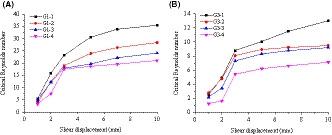当前位置:
X-MOL 学术
›
Energy Sci. Eng.
›
论文详情
Our official English website, www.x-mol.net, welcomes your feedback! (Note: you will need to create a separate account there.)
Effect of shearing on hydraulic properties of rough‐walled fractures under different boundary conditions
Energy Science & Engineering ( IF 3.8 ) Pub Date : 2019-11-27 , DOI: 10.1002/ese3.556 Changsheng Wang 1, 2 , Yujing Jiang 1, 2 , Hengjie Luan 1 , Satoshi Sugimoto 2
Energy Science & Engineering ( IF 3.8 ) Pub Date : 2019-11-27 , DOI: 10.1002/ese3.556 Changsheng Wang 1, 2 , Yujing Jiang 1, 2 , Hengjie Luan 1 , Satoshi Sugimoto 2
Affiliation

|
This study experimentally investigated nonlinear flow characteristics of rough‐walled fractures during shear process under different boundary conditions, using the servo‐controlled shear‐flow apparatus. A series of shear‐flow tests were conducted on two types of rough fractures with different shear displacements under various boundary conditions. The effects of shear process, fracture surface roughness, boundary normal stiffness, and initial normal stress on nonlinear flow behaviors are analyzed. The results show that Forchheimer equation provides a good description of the nonlinear relationship between flow rate and pressure gradient in rough‐walled fractures. The linear and nonlinear coefficients decrease by 1‐2 and 2‐3 orders of magnitude during shear, respectively. Both the mechanical aperture and the hydraulic aperture increase with increasing shear displacement. The mechanical aperture is always larger than the hydraulic aperture, and their difference gradually increases with the increment of shear displacement. The contact area ratio exhibits a fast decrease as shear displacement ranges between 1 and 3 mm and then decreases gradually with the decreasing rate generally diminishes. With the increase in shear displacement, the critical Reynolds number shows an increasing trend. The critical Reynolds number is in range 3.22‐35.41 for fracture G1 and 1.23‐12.35 for fracture G3. As the boundary normal stiffness and initial normal stress increase, the critical Reynolds number decreases.
中文翻译:

不同边界条件下剪切对粗糙壁裂缝水力特性的影响
这项研究使用伺服控制的剪切流动装置,通过实验研究了在不同边界条件下剪切过程中粗壁裂缝的非线性流动特征。在不同边界条件下,对两种具有不同剪切位移的粗糙裂缝进行了一系列的剪切流试验。分析了剪切过程,断裂表面粗糙度,边界法向刚度和初始法向应力对非线性流动行为的影响。结果表明,Forchheimer方程很好地描述了粗糙壁裂缝中流量与压力梯度之间的非线性关系。在剪切过程中,线性系数和非线性系数分别减小1-2和2-3个数量级。机械孔径和液压孔径都随着剪切位移的增加而增加。机械孔径始终大于液压孔径,并且它们的差异会随着剪切位移的增加而逐渐增大。当剪切位移范围在1和3 mm之间时,接触面积比会快速减小,然后随着减小速率的逐渐减小而逐渐减小。随着剪切位移的增加,临界雷诺数显示出增加的趋势。裂缝G1的临界雷诺数在3.22-35.41范围内,裂缝G3的临界雷诺数在1.23-12.35范围内。随着边界法向刚度和初始法向应力的增加,临界雷诺数减小。随着剪切位移的增加,它们的差值逐渐增大。当剪切位移范围在1和3 mm之间时,接触面积比会快速减小,然后随着减小的速率逐渐减小而逐渐减小。随着剪切位移的增加,临界雷诺数显示出增加的趋势。裂缝G1的临界雷诺数在3.22-35.41范围内,裂缝G3的临界雷诺数在1.23-12.35范围内。随着边界法向刚度和初始法向应力的增加,临界雷诺数减小。随着剪切位移的增加,它们的差值逐渐增大。当剪切位移范围在1和3 mm之间时,接触面积比会快速减小,然后随着减小的速率逐渐减小而逐渐减小。随着剪切位移的增加,临界雷诺数显示出增加的趋势。裂缝G1的临界雷诺数在3.22-35.41范围内,裂缝G3的临界雷诺数在1.23-12.35范围内。随着边界法向刚度和初始法向应力的增加,临界雷诺数减小。临界雷诺数呈上升趋势。裂缝G1的临界雷诺数在3.22-35.41范围内,裂缝G3的临界雷诺数在1.23-12.35范围内。随着边界法向刚度和初始法向应力的增加,临界雷诺数减小。临界雷诺数显示出增加的趋势。裂纹G1的临界雷诺数在3.22-35.41之间,而裂纹G3的临界雷诺数在1.23-12.35之间。随着边界法向刚度和初始法向应力的增加,临界雷诺数减小。
更新日期:2019-11-27
中文翻译:

不同边界条件下剪切对粗糙壁裂缝水力特性的影响
这项研究使用伺服控制的剪切流动装置,通过实验研究了在不同边界条件下剪切过程中粗壁裂缝的非线性流动特征。在不同边界条件下,对两种具有不同剪切位移的粗糙裂缝进行了一系列的剪切流试验。分析了剪切过程,断裂表面粗糙度,边界法向刚度和初始法向应力对非线性流动行为的影响。结果表明,Forchheimer方程很好地描述了粗糙壁裂缝中流量与压力梯度之间的非线性关系。在剪切过程中,线性系数和非线性系数分别减小1-2和2-3个数量级。机械孔径和液压孔径都随着剪切位移的增加而增加。机械孔径始终大于液压孔径,并且它们的差异会随着剪切位移的增加而逐渐增大。当剪切位移范围在1和3 mm之间时,接触面积比会快速减小,然后随着减小速率的逐渐减小而逐渐减小。随着剪切位移的增加,临界雷诺数显示出增加的趋势。裂缝G1的临界雷诺数在3.22-35.41范围内,裂缝G3的临界雷诺数在1.23-12.35范围内。随着边界法向刚度和初始法向应力的增加,临界雷诺数减小。随着剪切位移的增加,它们的差值逐渐增大。当剪切位移范围在1和3 mm之间时,接触面积比会快速减小,然后随着减小的速率逐渐减小而逐渐减小。随着剪切位移的增加,临界雷诺数显示出增加的趋势。裂缝G1的临界雷诺数在3.22-35.41范围内,裂缝G3的临界雷诺数在1.23-12.35范围内。随着边界法向刚度和初始法向应力的增加,临界雷诺数减小。随着剪切位移的增加,它们的差值逐渐增大。当剪切位移范围在1和3 mm之间时,接触面积比会快速减小,然后随着减小的速率逐渐减小而逐渐减小。随着剪切位移的增加,临界雷诺数显示出增加的趋势。裂缝G1的临界雷诺数在3.22-35.41范围内,裂缝G3的临界雷诺数在1.23-12.35范围内。随着边界法向刚度和初始法向应力的增加,临界雷诺数减小。临界雷诺数呈上升趋势。裂缝G1的临界雷诺数在3.22-35.41范围内,裂缝G3的临界雷诺数在1.23-12.35范围内。随着边界法向刚度和初始法向应力的增加,临界雷诺数减小。临界雷诺数显示出增加的趋势。裂纹G1的临界雷诺数在3.22-35.41之间,而裂纹G3的临界雷诺数在1.23-12.35之间。随着边界法向刚度和初始法向应力的增加,临界雷诺数减小。



























 京公网安备 11010802027423号
京公网安备 11010802027423号